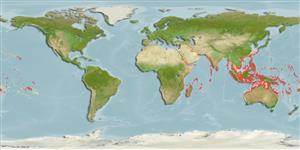Holothuroidea |
Holothuriida |
Holothuriidae
Environment: milieu / climate zone / depth range / distribution range
Ecology
Reef-associated; depth range 0 - 45 m (Ref. 800). Tropical; 30°N - 35°S, 32°E - 128°W (Ref. 97480)
Indo-Pacific.
Length at first maturity / Size / Weight / Age
Maturity: Lm ? range ? - ? cm Max length : 35.0 cm TL male/unsexed; (Ref. 122); common length : 20.0 cm TL male/unsexed; (Ref. 122); max. published weight: 300.00 g (Ref. 122)
Mean live weight 200 to 300 g; body-wall thickness 0.3 cm. Body cylindrical, elongate, eight rounded ends. Tegument rough. Podia sparse on bivium, ending in a small disc of around 100 micrometer in diameter; podia on trivium numerous, short and stout, distributed on the radii and interradii, their calcareous disc around 460 micrometer in diameter. Mouth ventral, surrounded by 20 grey tentacles. Anus sub dorsal. Calcareous ring with large radial pieces and narrow interradials. Cuvierian tubules absent. A characteristic black or dark mediodorsal band; coloration lighter laterally; trivium lighter, with small, dark dots. Spicules on tegument with tables and rosettes; tables with circular small disc, having a single hole in the middle, and bearing a spire ending in spines which may form a Maltese crown; presence of rosettes with holes (2 small and 2 larger holes); a second form of rosette with 6 holes and small perforated plates mostly found in the dorsal tegument; ventral podia with large plates and rods; dorsal podia with nodose rods or showing holes at their ends.
Not processed product looks similar to that of Holothuria atra and is of low commercial value. A common shallow water species; mostly on inner and outer flats of coastal reefs, back reefs, or shallow coastal lagoons; specimens from barrier reefs have been reported to have a brown bivium and whitish trivium. Most abundant on sandy-muddy grounds with rubble or coral patches and in seagrass beds (Refs. 122, 129602). Also common on sandy-silt sand mixed with coral rubble (Ref. 92930) and those with fine and coarse sand on seagrass (Ref. 129602). Mean population density around 0.1 per square meter or not exceeding 0.1 per square meter (Ref. 122).
Life cycle and mating behavior
Maturity | Reproduction | Spawning | Eggs | Fecundity | Larvae
Conand, C. 1998 Holothurians (sea cucumbers, Class Holothuroidea). p. 1157-1190. In Carpenter, K.E. and V.H. Niem (eds.) FAO Species Identification Guide for Fishery Purposes. The Living Marine Resources of the Western Central Pacific. Vol. 2. Cephalopods, crustaceans, holothurians and sharks. FAO Rome. (Ref. 122)
IUCN Red List Status
(Ref. 130435: Version 2025-1)
CITES status (Ref. 108899)
Not Evaluated
Not Evaluated
Threat to humans
Harmless
Human uses
Fisheries: minor commercial
| FishSource | Sea Around Us
Tools
More information
Life cycleReproduction
Maturity
Fecundity
Spawning
Eggs
Egg development
Larvae
PhysiologyOxygen consumption
Human RelatedStamps, coins, misc.
Internet sources
Estimates based on models
Preferred temperature
(Ref.
115969): 24.7 - 29, mean 28 (based on 1264 cells).
Fishing Vulnerability
Low vulnerability (25 of 100).
Price category
Unknown.
Nutrients : Calcium = 126 [75, 177] mg/100g; Iron = 4.79 [1.67, 7.92] mg/100g; Protein = 16.6 [15.4, 17.8] %; Omega3 = 0.331 [0.263, 0.400] g/100g; Selenium = 57.8 [48.5, 67.2] μg/100g; VitaminA = 0 μg/100g; Zinc = 1.97 [0.92, 3.02] mg/100g (wet weight); based on
nutrient studies.
